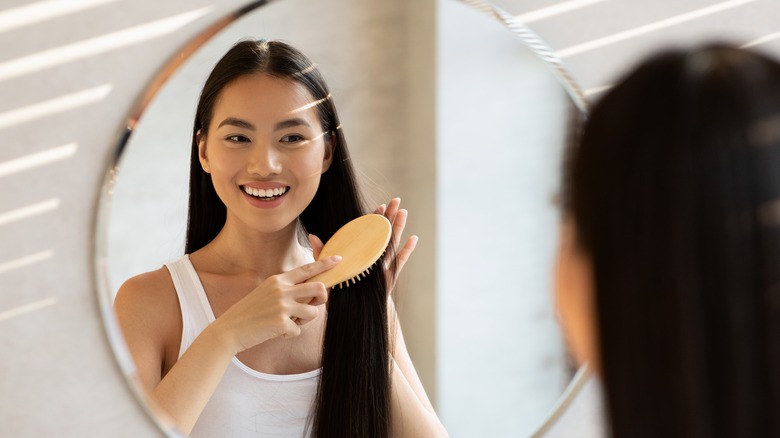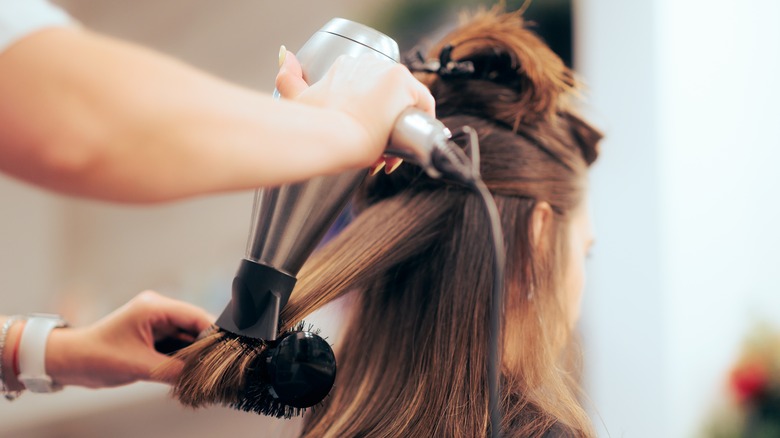The Easy Hack That Can Help You Determine Your Hair's Porosity
If you are someone who often finds themselves sitting in a hairstylist's chair for regular toner touch-ups, highlights, and the occasional glam balayage, then you've probably heard the term "hair porosity" come up at one point or another. But what exactly does it mean when your stylist tells you that you have high porosity hair? Simply put, porosity refers to the hair's ability to hold moisture, per Healthline. Your hair's porosity indicates how well water, oil, chemicals, and hair products can pass through the hair's cuticle, which is the outermost layer of each hair strand.
Learning your hair's porosity level can help you better understand your hair's overall health, which will determine how your hair responds to chemical treatments, styling products, and treatments. Your hair's porosity can land anywhere between low, medium, and high, and it's also possible for your hair to have a combination of different porosity levels similar to how one's curl pattern can differ from one strand to the other. In most cases, you will often notice that the roots of your hair will have a different porosity level than the ends, and this can be caused by heat styling, bleach, or chemical treatments.
So, how can you determine your hair's porosity, and what's the difference between the three main grades of porosity? Here's how you can find out.
How to test your hair's porosity at home
There are three easy methods for testing your hair's porosity at home. The first method is the float test, which involves observing if your hair floats or sinks in water. For this method, remove a strand of hair from your hairbrush or directly from your head, and place it in a glass of water. If the hair briefly floats before sinking, then you have low porosity hair. If your hair simply sinks, then you likely have high porosity hair. If the hair doesn't sink or remain at the top but floats in the middle, then you have medium porosity hair.
The second test involves using a spray bottle to observe how quickly the hair absorbs water. If the water droplets sit on the surface of your hair, then you likely have low porosity, while if your hair immediately absorbs the water then you have extremely porous hair. And if you observe several water droplets that absorb into the hair immediately after, then you have normal porosity hair.
The last test involves feeling the texture of your hair by separating a single strand and gently sliding your finger upwards, toward your scalp, to feel for bumps. A bumpy texture indicates high porosity while a smooth texture indicates low porosity. For all of these porosity tests, it's important to note that you want your hair to be clean for accurate results.
What's the difference between low, medium, and high porosity?
So, what does it really mean to have low, medium, or high porosity hair? Natural oils and water should be able to pass through the cuticle and reach the core layer so your hair can remain healthy, per Healthline. If you have low-porosity hair, then your cuticles are closely packed together and this makes it difficult for water, oils, and hair products to pass through. It can be tricky, therefore, for color or chemical treatments to penetrate the hair. Low porosity hair is often dry, difficult to wet, and will take longer to dry, as a result.
On the other hand, if you have high porosity hair then your cuticles are widely spaced and open, which makes the hair "leaky" so it is difficult to retain a healthy amount of moisture. High porosity hair is, thus, prone to breakage, frizziness, and dryness if too much moisture is absorbed, especially in humid climates, per Naturally Curly. This hair type is often a result of heat damage, bleach, and chemical treatments.
If you are lucky enough to have medium hair porosity, then your cuticles are neither too closely packed nor too open, which allows a balanced amount of water and oil to enter the core layer and absorb into the hair. This hair type is commonly seen in virgin hair, and it's generally considered to be healthy and low maintenance compared to low and high-porosity hair.


